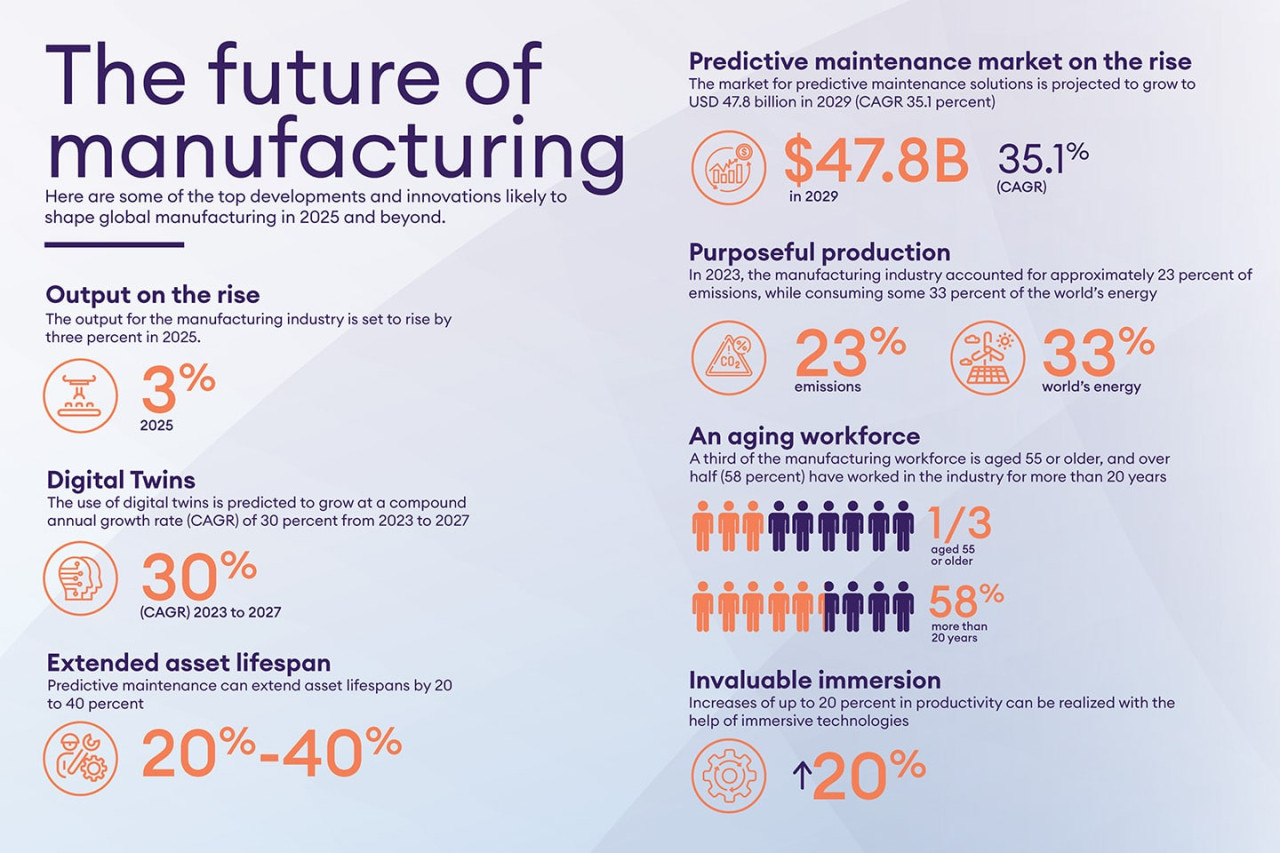Judging by the conversations I have had with those people at the manufacturing frontline, this positive development is to a large degree driven by the increasing adoption of Industry 4.0 technologies and practices among businesses around the world. As the industry grows smarter, here are my four key takeaways from my conversations with leading manufacturers this year. These major trends and innovations are highly likely to shape global manufacturing in 2025 and beyond.
1. Advancing Digitalization
In the world of manufacturing, digitalization is often synonymous with automation. This is something that manufacturers have always excelled at. Simultaneously, sensors and endpoints are widespread and their numbers growing, a noticeable upsurge from Gartner's 21 billion estimate back in 2020. What this means is that clearly, businesses can capture data like never before.
I expect that we will see accelerated efforts to augment automation with data to drive even smarter factories and equip decision-makers with unprecedented insights, especially when it comes to enterprise asset management (EAM). We should also expect digital twins—an area predicted to grow at a compound annual growth rate (CAGR) of 30 percent from 2023 to 2027—to play an integral role in this development as businesses look for intelligent ways to transform vast fields of unstructured data into a centralized model that helps visualize complex assets and improve collaboration between departments and functions.
As digitalization picks up even more momentum over the coming years, so will the associated risks. By digitizing processes and value chains, companies are exposing themselves to the threat of data security challenges, including malware incidents, loss of data, or Denial-of-Service (DoS) attacks that have the potential to cripple businesses. Given the magnitude of the risks involved, I believe that we will see increased focus among manufacturing businesses to invest in effective cybersecurity measures. This will, in turn, lead to an industry-wide strengthening of supply chain integrity.
Advancing digitalization and automation will naturally influence the workforce. However, rather than replacing those roles filled by humans, technology will instead be used as a tool to help improve the efficiency of personnel to make workdays more productive and flexible. In other words, when digitalization has automated those tasks that do not benefit from human intervention, workers are free to turn their attention to more complex tasks where value can be added.
2. AI-Powered Predictive Maintenance
As the above-mentioned figures from Gartner indicate, the industry is connecting assets at a furious pace. This increase in available data is the driving force behind an advancement in predictive maintenance initiatives, which I believe will help shape the manufacturing sector in the years to come. The most crucial component of any effort in this area is the EAM solution and how it connects to the company’s installed base of assets. After all, the more interconnected the EAM solution and your assets become, the more imperative it is to predict and project on asset failure. With the help of data-driven insights, predicting when a machine will fail will allow businesses to take measures to prevent this from happening.
The growing interest in predictive maintenance is hardly surprising given the financial incentives. For example, predictive maintenance can save up to 40 percent in costs compared to reactive maintenance and 8–12 percent when compared to preventive maintenance. Predictive maintenance can also extend asset lifespans by 20–40 percent. No wonder the market for these solutions is projected to grow to USD 47.8 billion in 2029 (CAGR 35.1 percent).
Artificial Intelligence (A) is a key differentiator that will drive all major advancements in predictive maintenance for years to come. Making sense of and operationalizing sensory data, AI models will retain their looming presence in enterprise asset management as companies explore new ways of harnessing machine learning to enhance error detection and prevention, while increasing energy efficiency.
3. Purposeful production
At the same rate the global population is growing, so is our demand for goods and services. To meet this demand, greenhouse gas emissions have increased by 50 percent over the last three decades. In 2023, according to the US Environmental Protection Agency, the manufacturing and raw materials industries accounted for approximately 23 percent of emissions, while manufacturing consumed some 33 percent of the world’s energy.
As a result of these rather sobering figures, I see a clear shift among manufacturers toward a more purposeful production wherein goods are made in a way that minimizes the environmental footprint, conserves resource and considers both the social and economic aspects of its impact.
What we are seeing now and in the coming years is a global shift to a circular economy that lets us reduce waste and use resources more efficiently. As these new imperatives are becoming reality, manufacturers will need to adopt technology to help implement lean processes, ensure increased productivity, minimize energy consumption, ensure supply chain traceability, enhance workplace safety and much more.
For the manufacturing sector, this is a sea change that imposes increasingly stringent demands on operations; not only in terms of supply chain visibility and raw material sourcing, but also when it comes to the emissions and energy consumption of their factories. For this reason, many businesses will need to overhaul production methods, maintenance practices, and reporting capabilities.
4. The changing workforces, and skills shortages
There’s a clear shift in the way maintenance departments operate that will reach a critical inflection point in 2025. As internal processes become increasingly digitized, maintenance workers must become more adept at using different technologies, tools and platforms. New skillsets are required around the collection, analysis and interpretation of data that will assure manufacturers are fit for the future.
The lack of skilled personnel is acute. A third (31 percent) of companies outsource operations because skilled individuals are hard to find, and over half (58 percent) of manufacturing employees have worked in the industry for more than 20 years.
While manufacturers have been dealing with an aging workforce for some time, they would be wise to start hiring on skillsets that better match the technological requirements and advancements of tomorrow, versus talent that will follow directly in the footsteps of today’s engineers.
Looking further to the future, immersive technologies such as virtual reality (VR), mixed reality (MR), and augmented reality (AR) are set to redefine how all industries function. In the manufacturing sector, metaverse-based tools will unlock new vistas of opportunity. For example, VR technology can help staff to develop their skills without leaving the room. MR and AR can likewise empower workers to solve problems in the field by tapping into a central knowledge repository or by drawing on the skills of remote coworkers. Besides savings in time, cost and effort, reports suggest monumental increases in productivity of up to 20 percent. The business case for immersive technology is a compelling one.
Immersive technology holds the potential to revolutionize the way manufacturing operates, and the growing reliance on predictive analytics, AR, VR, and other advanced technologies will demand a workforce proficient not just in basic digital skills, but also in using these sophisticated tools in their daily work.
With a third of the manufacturing workforce at age 55 or older, businesses will be forced to make changes in order to attract younger generations of workers. Over the next few years, I believe that a vanguard of manufacturing businesses will start deploying immersive and other emerging technology to appeal to generation-now workers whose digital nativeness and low threshold for adoption will unlock new efficiencies and ways of working.
The future is bright
Despite some of the challenges outlined above, I see a bright future for the manufacturing industry. Speaking with customers, partners, and industry experts, it is clear to me that there has never been a more opportune moment to improve, streamline and innovate. Combining the potential of cutting-edge technology with the responsible and sustainable ethos of purposeful production, I am convinced that the manufacturing industry is ready to face the future.
For which sectors is IFS Ultimo software suited?
If your organization utilizes capital-intensive assets, IFS Ultimo's best-of-breed EAM is an invaluable tool for optimizing your asset management. Ultimo excels in manufacturing, logistics, healthcare, infrastructure and utility sectors.
-
Do you have capital-intensive assets? Then an EAM system is an invaluable tool for optimizing their management. Ultimo is well represented in the manufacturing, logistics, healthcare, infrastructure and utility sectors. View our cases.
Latest resources
Request a demo
Get your questions answered. Schedule a personalized demo to see how Ultimo can add ease and value to your business. No strings attached.










